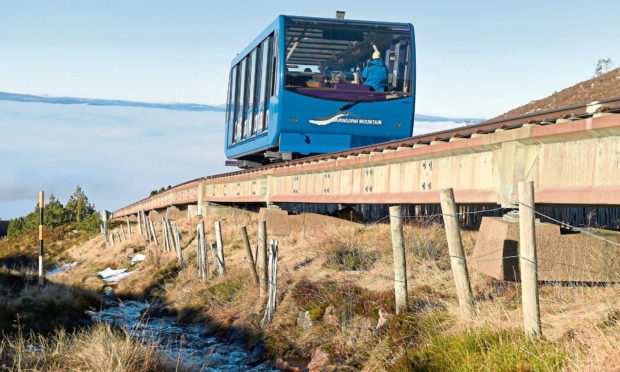God knows, I’m no economist. Being a nature writer for a living is a bit of a giveaway.
If you have an interest in economics (a social science concerned chiefly with the production, distribution and consumption of goods and services, according to my much-mutilated copy of the Penguin English Dictionary of which the hard cover and the binding are sorrowfully parting company, yet I lack the economic resources/inclination to fashion a replacement), you would choose to do something else.
But given that nature conservation and politics sometimes rub shoulders or cross swords, or get in each other’s way, my day job requires me to think economically on occasion. This, alas, is one such.
“Lifeline £20m pledge will see Cairngorm railway reopened”, a headline in The Courier proclaimed, and the social science of economics stirred in the stoorie backwoods of my brain where it lives in semi-permanent hibernation. I can always tell when it is stirring because a groan escapes from my lips, a groan over which I have no control.
Economics vs ecology
Cairn Gorm is a singularly significant mountain in arguably the single most significant mountain landscape in Scotland, the Cairngorms, a landscape that, ecologically, is one of the most significant in Europe. It is also in a national park. These facts alone should be enough to safeguard the landscape’s wellbeing above all other considerations, even economic ones. Should be. But economics began to butt in almost 100 years ago.
In 1923, the fledgling Forestry Commission bought Cairn Gorm and Glen More, and a species of ecological rot set in so that economics might flourish. It is perhaps worth pausing in what promises to be a grim narrative to quote the great Seton Gordon, founding father of the modern Scottish nature writing tradition. His book, The Cairngorm Hills of Scotland, was published in 1925, so somewhere around the same time as the commission moved in, he was writing this:
“In the immense silences of these wild corries and dark rocks, the spirit of the high and lonely places revealed herself, so that one felt the serene and benign influence that has from time to time caused men to leave the society of their fellows and live on some surf-drenched isle – as St Cuthbert did on Farne – there to steep themselves in those spiritual influences that are hard to receive in the crowded hours of human life…”
What makes the sentiment particularly relevant is that he was moved to write it while contemplating the northern corries of Cairn Gorm, now corrupted far beyond anything he would recognise, thanks to Scottish skiing and Scottish tourism and their colossal indifference to arctic-alpine ecology. And thanks to economics.
Spiral of decline
A progressive spiral of the landscape’s decline began in 1957 when the commission leased part of Cairn Gorm to the Cairngorm Winter Sports Development Company. Three years later the first road was built. The litany of subsequent development, compounded by ignorance of and indifference to the fragility of the mountain’s arctic-alpine ecology has progressed more or less unimpeded to the present day.
The wedding of the skiing industry to the tourist industry has morphed into the grotesquely named Cairngorm Mountain resort. Not only is the mountain’s name wrongly spelled (Cairn Gorm for the mountain, Cairngorms for the range, Cairngorm only acceptable as an adjective for Cairngorms), but the name Cairn Gorm means blue rocky mountain, so Cairngorm mountain makes as much sense as Firth of Tay estuary or Loch Lomond lake. Tourism doesn’t care, as long as thousands drive up the mountain and take the ski tows or the funicular railway to the mountaintop restaurant and visitor centre. Economics.
And the railway doesn’t work. In this, its second incarnation, it hasn’t worked since 2018. And now Scotland’s rural economy secretary has pledged £20 million to fix it and ensure the mountain can be “a destination people can enjoy all year round…” and the funicular “will not only transport thousands of annual visitors up Cairn Gorm again next winter, it will also bring access to the mountain environment to a broad range of visitors…”
Trampled underfoot
No, it won’t. The true “mountain environment” bears no relation to what a broad range of visitors can access via the funicular. The mountain environment of the northern corries is what Seton Gordon documented, and that has been aggressively trampled underfoot by the thoughtlessness of skiing and tourism acting in tandem.
The worst aspect of the secretary’s decision was that the “business case” for spending £16m of the allotted £20m on the railway was only the “preferred option” because it would have cost £17m to remove the structure. In other words, what could have amounted to a trailblazing gesture by the Scottish Government to begin the process of healing the mountain, of brandishing the virtues and the accomplishments of ecology over economics…that gesture was discarded to save a million pounds.
That gesture could have transformed the priorities of Scotland’s national parks, and set an example to other landowners.
Economics: Ecology always loses out to it. But what do I know? God knows, I’m no economist.










